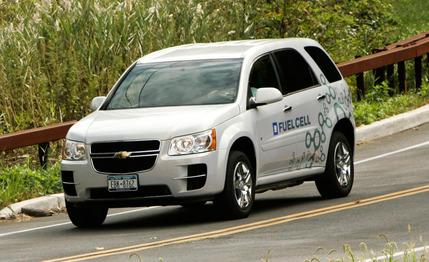 First Drive Review
First Drive Review
The zero-emission, hydrogen-powered Chevrolet Equinox offers a glimpse at what driving could be like in the future, even if its limited range puts a serious crimp in its present-day utility. Like Honda, BMW, and many other auto manufacturers, General Motors has been busy developing hydrogen-powered vehicles as a long-term alternative to traditional fossil-fuel powerplants.
Based on the Equinox crossover, GM’s fourth-generation hydrogen fuel-cell stack resides under the little truck’s deceptively stock-looking exterior. There are currently 100 Equinox fuel-cell vehicles (FCVs) plying the streets of America, with the majority in New York, California, and Washington, D.C. A few have been put into the hands of photogenic enviro-friendly celebrities; others have been loaned to everyday people courtesy of GM’s Project Driveway program. These vehicle loans last for three months, with GM covering all insurance—a good thing, since each hand-built Equinox FCV costs upward of $1 million—plus hydrogen refueling costs. In return for its generosity to hoi polloi, GM gets valuable real-world feedback about its latest fleet of fuel-cell vehicles.
Fuel Cells for Dummies
We picked up our Equinox at GM’s training center in Ardsley, New York, 20 miles north of New York City. There to greet us was Stephen Marlin, a driver-relationship manager with GM and our guide to the ins and outs of the technology lurking within the Equinox.
“It’s really only eighth-grade levels of science at work,” said Marlin, as he popped open the carbon-fiber hood to show off the rectangular box that is the fuel-cell stack. In the simplest terms, a fuel cell generates electricity by combining oxygen in air with pure hydrogen (or a hydrogen-rich fuel) that is stored in fuel tanks. In the case of the Equinox, the motor runs on pure pressurized hydrogen. The biggest party trick of the Equinox: The exhaust emissions consist of nothing but water vapor. Yes, you could drink it if you really wanted to, although we decided to opt against having a quick swig of hydrogen exhaust.
The fuel cell itself is made of stacks of high-tech cathode-and-anode sandwiches, separated by a thin membrane “about the size of a sheet of paper,” according to Marlin. In the Equinox there are 400 of these stacks, which produce a combined total of roughly 400 volts. A major component of this membrane is platinum, which partly explains the huge price tag still associated with fuel-cell vehicles. Why not use a cheaper metal? Marlin explained that the trade-off would be limited engine life. Cheaper components would bring costs down but would ultimately limit the working life of the powertrain. At the moment, the fuel cell needs to be completely replaced as early as the 50,000-mile mark.
A Time Machine with Airbags, but Minus the Flux Capacitor
For a car (er, crossover) of the future, the Equinox FCV is pretty darned subdued. True, the Glacier Gold tri-coat paint and “Fuel Cell” decals are impossible to miss. The front grille is larger, to improve airflow around the fuel cell, and the headlights come from a Pontiac Torrent. To clear the fuel-cell stack and reduce weight, the hood is of lightweight carbon fiber. Inside, body-colored panels cover swaths of the plasticky but functional dashboard. A kilowatt gauge replaces the tachometer, and the standard rear bench has been substituted for two individual rear seats. The rear center seat, plus a small amount of cargo space, is sacrificed to make room for the hydrogen fuel tanks.
For those worried about blowing up like an ammo dump in a Rambo movie, know that GM has spared no expense in ensuring that the Equinox FCV meets all federal safety standards. The vehicle has undergone a battery of tests, including 35-mph crash tests conducted by the National Highway Traffic and Safety Administration, along with more colorfully named ones, such as “gunfire permeation” and “bonfire.” Seven hydrogen sensors are located throughout the cabin and engine compartment, and the motor will automatically shut down and passengers will be immediately instructed to exit the vehicle in the event of a hydrogen leak.